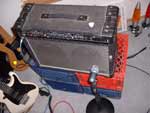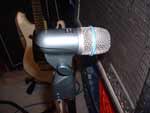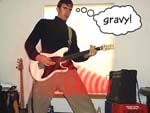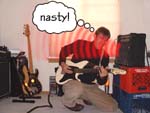Tips for miking a guitar amp and getting good tone.
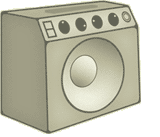
I often cringe when amateur electric guitarists perform onstage, not because they aren't any good, but because they have bad tone. It's a pretty common pattern that has to do with the fact that the guitarist cranks up the high-mid/high frequencies.
Why would this be? Don't they know how to tweak their sound? Do the sound guys in the back not know what they're doing? Does the sound system suck? Is the mic positioned wrong? Any of these factors can work against a guitarist and his tone, but none of these explain the pattern I'm talking about.
Amp miking 101:
For background, I'll give a brief overview of proper mic placement. Mics are usually placed between one and ten inches away from the speaker grille and sixty-six percent of the way from the center axis to the outer rim of the speaker. Closer placement to the grille will put more low-end in the sound, especially if the mic has a "proximity effect", and will also allow less bleed-in from other sound sources on stage. Closer placement to the center axis of the cone will increase the brilliance of the sound. Also if the amp is sitting on the floor you might pick up more low end than if you set it all up on a chair.
But even when all this is done right the pattern of bad tone persists. What lies at the root of this problem?
The root of the problem:
The pattern is rooted in how guitarists listen to their amps. Experienced guitarists know what their amp sounds like, not just from their point of view standing or sitting next to the amp, but from the microphone's point positioned directly in front of the amp. They set the EQ accordingly.
Inexperienced guitarists, on the other hand, tend to be oblivious to these details. An amp has a "hot zone" directly in front of the speaker where the high frequencies are louder. Standing outside this hot zone, they boost their amp's EQ settings until it sounds right to them, but they don't realize that they may be sending way too much high end to the audience, because the mic is sitting directly in the hot zone in front of the amp. Ouch!
What's a guitarist to do?
So what? How do we guitarists avoid this pitfall? For starters, a good idea may be to set the amp on a table or tilt it back and wedge some books or something underneath it. Point the amp straight at your head and get to know that sound. Do whatever it takes to be able to hear the same tone your audience hears, and only then then dial in your tone. Don't forget to make notes of your settings so that you can reproduce them anywhere. A big part of being a performer is to know exactly how the audience perceives you.
Additional tips
Preproduction. If you really care about sounding good to the audience, spend some time getting to know your amp and what the knobs really do. Sometimes EQ knobs labelled "low", "mid" and "high" have very strange personalities on guitar amps, especially tube ones. If you can, record yourself and listen to the playback. You may be blown away by the differences you hear as you make small changes to the mic position and tone settings.
The Smiley Face. Beware the smiley face. When you “scoop” your sound by boosting highs and lows while cutting the mids (which makes a smiley on a graphic EQ) it can have an impressive effect. Without getting into too much technical detail about weighting and the physics of the human ear, I'll try to explain why you shouldn't trust the smiley face. It's a trick of perception—like an optical illusion—where the ear is tricked into thinking the sound is louder than it really is. When the sound is already loud, like at a concert, the effect is lost and you wind up with all high and low and no mids.
Distortion. When using overdrive or distortion, be careful not to wash out the signal. A common mistake for an inexperienced guitarist is to use too much distortion and end up with a wimpy, white noise kind of sound. Heaviness comes from a lot of subtle dynamics, not just from the distortion.
Controlling your tone. Your sound travels through a long series of checkpoints before reaching somebody's ears. First is the way you actually play play the instrument. Next is the tone of the instrument itself (which I consider the amp and footpedal effects to be a part of). Then comes the mic setup, then the mixer, EQ and outboard effects, then enhancement, equalization and compression, then the front of house speakers and finally the acoustics of the space. At each point you have less ability to fix or improve the sound, so your effort is best spent focusing on getting your gear dialed in right and not worrying too much about the other factors. If you can go anywhere, plug in, and give the sound engineer great sound right off the bat, you're doing better than most guitarists out there.
